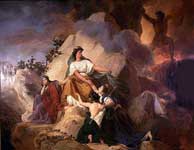.
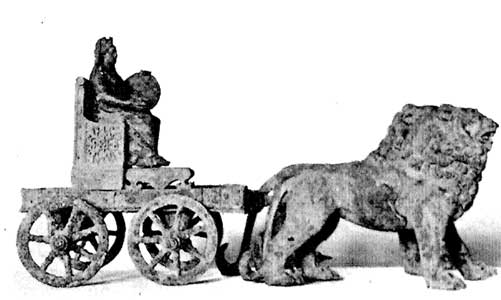
Cybele , Metropolitan Museum
Originally a Phrygian goddess, Cybele (Greek Κυβέλη, sometimes given the etymology "she of the hair" if her name is Greek, not Phrygian) (Roman equivalent: Magna Mater or 'Great Mother') was the Earth Mother goddess who was worshipped in Anatolia from Neolithic times. Like Gaia or her Minoan equivalent Rhea, Cybele embodies the fertile earth, a goddess of caverns and mountains, walls and fortresses, nature, wild animals (especially lions and bees). Her title 'Mistress of the Animals,' which is also borne by the Minoan Great Mother, reveals her ancient Paleolithic roots. She is a life-death-rebirth deity. Her consort, whose cult was introduced later, is her son Attis.
Cybele was supposed to have been born on Mount Ida in Asia Minor; this is the source of her epithet Idaea.
Cybele's most ecstatic followers were castrated males called Galli by the Romans, who led the people in orgiastic ceremonies with wild music, drumming and dancing and drink. She was associated with the mystery religion concerning her son, Attis, who was castrated and resurrected. The dactyls were part of her retinue. Other followers of Cybele, Phrygian kurbantes or Corybantes expressed her ecstatic and orgiastic cult in music especially drumming, clashing of shields and spears, dancing, singing, shouts, all at night.
Atalanta and Hippomenes were turned into lions by Cybele after having sex in one of her temples.
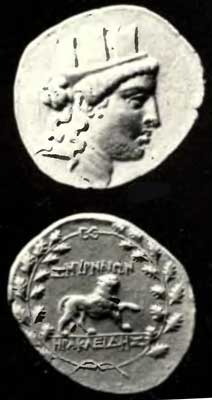
Smyrna Tetradrachm, Cybele, walking lion, Text SMYRNAION, HERAKLEIDES
Overview: Anatolia, Greece and Rome
At Pessinos in Phrygia, an archaic version of Cybele had been venerated as Agdistis since archaic times. In 203 BC, the aniconic cult object that embodied the Great Mother at Pessinos was ceremoniously and reverently removed to Rome.
Her cult had already been adopted in 5th century BC Greece, where she is often referred to euphemistically as Meter Theon Idaia ("Mother of the Gods, from Mount Ida") rather than by name. Mentions of Cybele's worship are found in Pindar and Euripides, among others. Classical Greek writers, however, either did not know of or did not mention the transgendered galli; although they did know of the castration of Attis. Cybele's cult in Greece was closely associated with, and apparently resembled, the cult of Dionysus
Anatolian Cybele
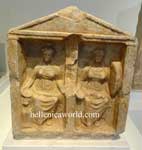
1540 : Votive relief of Cybele, Anatolian and Greek Version
Cybele's Anatolian origins probably predate the Bronze Age.
A figurine found at Çatal Hüyük, (Archaeological Museum, Ankara), dating about 6000, depicts the corpulent and fertile Mother Goddess, in the process of giving birth while seated on her throne, which has two handrests in the form of lion's heads. At her shrine at Çatal Hüyük she was depicted with the mural crown that promised she could be a protector of cities.
In the 2nd millennium BC Cybele was known to the Hittites and Hurrians as Kubaba.
In Phrygia Rhea/Cybele was venerated as Agdistis, with a temple at the great trading city Pessinos, mentioned by the geographer Strabo. It was at Pessinos that her son and lover Attis was about to wed the daughter of the king, when Agdistis/Cybele appeared in her awesome glory, and he castrated himself.
In Archaic Phrygian images of Cybele, her typical representation is in the figuration of a building’s façade, standing in the doorway. The façade itself can be related to the rock-cut monuments of the highlands of Phrygia. She is wearing a belted long dress, a head polos (high cylindrical hat), and a veil covering the whole body. In Phrygia, her usual attributes are the bird of prey and a small vase. Lions are sometimes related to her, in a aggressive but tamed manner.
Later, the sculptor Agoracritos, a pupil of Pheidias produced a version of Cybele that became the standard one. It showed her still seated on a throne but now more decorous and matronly, her hand resting on the neck of a perfectly still lion and the other holding the circular frame drum, like a tambourine, (tymbalon or tympanon), which evokes the full moon and is covered with the hide of the sacred lunar bull.
In Mysia Mount Dindymus was sacred to Cybele.
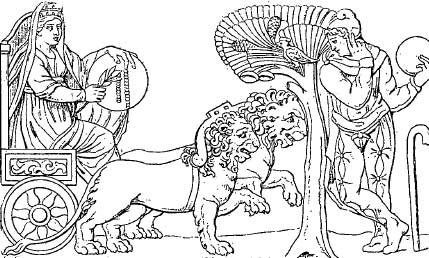
Cybele and Attis
The goddess appears alone, 8th–6th centuries BC. Later she is joined by her son Attis, who incurred her jealousy. He, in an ecstasy, castrated himself, and subsequently died. Grieving, Cybele resurrected him. The evergreen pine and ivy were sacred to Attis.
Some ecstatic followers of Cybele, know in Rome as galli, willingly castrated themselves in imitation of Attis. For Roman devotes of Cybele Mater Magna who were not prepared to go so far, the testicles of a bull, one of the Great Mother's sacred animals, were an acceptable substitute, as many inscriptions show. An inscription of AD 160 records that a certain Carpus had transported bull's testes from Rome to Cybele's shrine at Lyon, France.
Aegean Cybele
The worship of Cybele spread from inland areas of Anatolia and Syria to the Aegean coast, to Crete and other Aegean islands, and to mainland Greece. She was particularly welcomed at Athens. The geographer Strabo (book x, 3:18) made some useful observations:
"Just as in all other respects the Athenians continue to be hospitable to things foreign, so also in their worship of the gods; for they welcomed so many of the foreign rites ... the Phrygian [rites of Rhea-Cybele are mentioned] by Demosthenes, when he casts the reproach upon Aeskhines' mother and Aeskhines himself, that he was with her when she conducted initiations, that he joined her in leading the Dionysiac march, and that many a time he cried out evoe saboe, and hyes attes, attes hyes; for these words are in the ritual of Sabazios and the Mother [Rhea]."
In Alexandria, Cybele was worshipped by the Greek population as "The Mother of the Gods, the Savior who Hears our Prayers" and as "The Mother of the Gods, the Accessible One." Ephesus, one of the major trading centers of the area, was devoted to Cybele as early the 10th century BC, and the city's ecstatic celebration, the Ephesia, honored her.
The goddess was not welcome among the patriarchal Scythians north of Thrace. From Herodotus (4.76-7) we learn that the Scythian Anacharsis (6th century BC), after traveling among the Greeks and acquiring vast knowledge, was put to death by his fellow Scythians for attempting to introduce the foreign cult of Magna Mater.
Roman Cybele
In Rome, when the worship of Cybele, as Magna Mater, was formally initiated in 203 BC, Rome was embroiled in the Second Punic War at the time. The previous year, an inspection had been made of the Sibylline Books, and some oracular verses had been discovered which announced that whenever a foreign foe should carry war into Italy he could be driven out and conquered, if the Mater Magna were brought from Pessinos [in Phrygia] to Rome. Scipio was ordered to go to the port of Ostia, accompanied by all the matrons, to meet the goddess. He was to receive her as she left the vessel, and when brought to land he was to place her in the hands of the matrons who were to bear her to her destination, the Temple of Victory on the Palatine Hill. The day on which this event took place, 12 April, was observed afterwards as a festival, the Megalesian. (Livy, History of Rome, c. AD 10)
In Rome, her Phrygian origins were recalled by Catullus, whose famous poem on the theme of Attis includes a vivid description of Cybele's worship: "Together come and follow to the Phrygian home of Cybele, to the Phrygian forests of the goddess, where the clash of cymbals ring, where tambourines resound, where the Phrygian flute-player blows deeply on his curved reed, where ivy-crowned maenads toss their heads wildly."
Roman devotion to Cybele ran deep. Not coincidentally, when a Basilica was built over the site of a temple to Cybele to occupy the site, it was dedicated as Basilica di Santa Maria Maggiore.
The worship of Cybele penetrated as far as Mauretania. In Mauretania, just outside Setif, after a disastrous fire, the ceremonial "tree-bearers" and the faithful (religiosi) restored the temple of Cybele and Attis, 288 AD. Lavish new fittings, paid for by the private group included the silver statue of Cybele and the chariot that carried her in procession received a new canopy, with tassels in the form of fir cones. (Robin Lane Fox, Pagans and Christians, p 581.)
Notes
A monumental statue of Cybele can be found in one of the principal traffic circles of Madrid, the Plaza de Cibeles.
Berecynthian Goddess (The). Cybelê is so called from mount Berecyntus, in Phrygia, where she was held in especial adoration. She is represented as crowned with turrets, and holding keys in her hand.
Cobham Brewer, Character Sketches of Romance, Fiction and the Drama:
Her helmèd head
Rose like the Berecynthian goddess crowned
With towers.
Southey, Roderick, etc., ii. (1814).
Links
- http://www.fordham.edu/halsall/ancient/romrelig2.html
- Classical Mythology, translates the Catullus poem "Attis."
- http://www.gendercentre.org.au/37article3.htm
Further reading
Roller, Lynn E. In Search of God the Mother: the cult of Anatolian Cybele (U. of California Press, 1999)
65 Cybele is an asteroid.
See also : Greek Mythology. Paintings, Drawings
Greek Mythology Index
A - B - C - D - E - F - G - H - I - J - K - L - M -
N - O - P - Q - R - S - T - U - V - W - X - Y - Z
Α - Β - Γ - Δ - Ε - Ζ - Η - Θ - Ι - Κ - Λ - Μ -
Ν - Ξ - Ο - Π - Ρ - Σ - Τ - Υ - Φ - Χ - Ψ - Ω
| Ancient Greece
Science, Technology , Medicine , Warfare, , Biographies , Life , Cities/Places/Maps , Arts , Literature , Philosophy ,Olympics, Mythology , History , Images Medieval Greece / Byzantine Empire Science, Technology, Arts, , Warfare , Literature, Biographies, Icons, History Modern Greece Cities, Islands, Regions, Fauna/Flora ,Biographies , History , Warfare, Science/Technology, Literature, Music , Arts , Film/Actors , Sport , Fashion --- |
Retrieved from "http://en.wikipedia.org"
All text is available under the terms of the GNU Free Documentation License


